1976 CHEVROLET VEGA inflation pressure
[x] Cancel search: inflation pressurePage 14 of 87

Downloaded from www.Manualslib.com manuals search engine Trailer Hauling
Since passenger cars are designed
and intended to be used primarily
as passenger conveyances, towing
a trailer will effect handling, dura
bility
and economy. Maximum
safety and satisfaction depends
upon proper use of correct equip
ment and avoiding overloads and
other abusive operation.
The maximum loaded trailer
weight which you can pull with
your car depends on what special
equipment has been installed on
your car. Chevrolet does not rec- ommend
towing any trailer
over
1,000 pounds gross trailer weight.
Information on trailer haul
ing capabilities, special equipment
required, and optional equipment
offered by Chevrolet
is available
from your Chevrolet Dealer or by
writing Chevrolet Motor Division,
Detroit, Michigan 48202
(or in
Canada by writing to General
Motors of Canada Limited,
Owner
Relations Department, Oshawa,
Ontario LlJ 5Z6).
To assist in attaining good han
dling of the car-trailer combination,
it
is important that the trailer
1-9
tongue load be maintained at ap
proximately 10%
of the loaded
trailer weight. Tongue loads can
be adjusted by proper distribution
of the load in the trailer, and can
be checked
by weighing separately
the loaded trailer and then the
tongue.
When towing trailers, tires should
be inflated to the highest inflation
pressures shown on the placard
affixed
to the left front door. The
allowable passenger and cargo
load, also shown on the same pla
card,
is reduced by an amount
eq ual to the trailer tongue load on
the trailer hitch.
Page 50 of 87
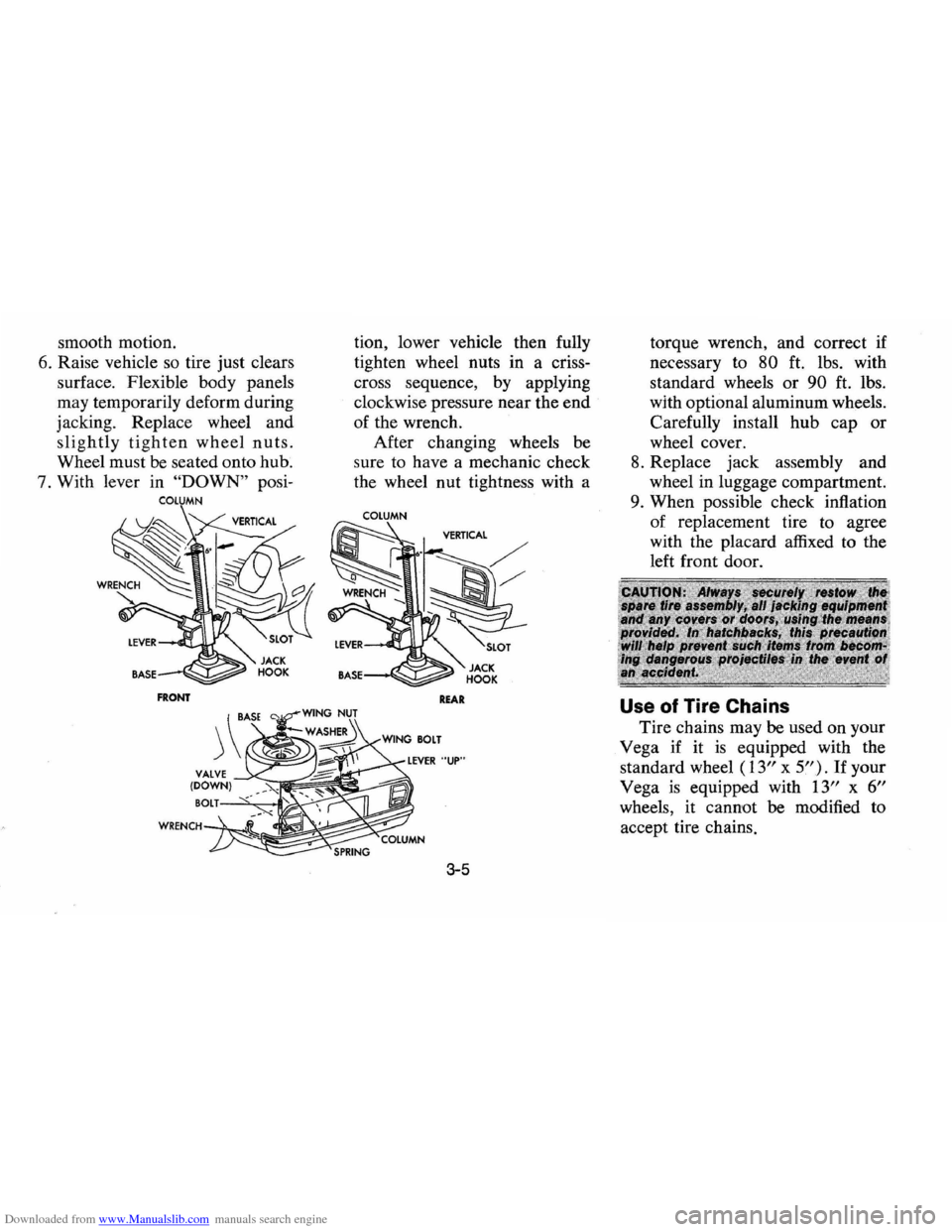
Downloaded from www.Manualslib.com manuals search engine smooth motion.
6. Raise vehicle so tire just clears
surface. Flexible body panels
may temporarily deform during
jacking. Replace wheel and
slightly tighten wheel nuts.
Wheel must be seated onto hub.
7. With lever in
"DOWN" posi
COLUMN
FRONT
tion, lower vehicle then fully
tighten wheel nuts in a criss
cross sequence, by applying
clockwise pressure near the
end
of the wrench.
After changing wheels
be
sure to have a mechanic check
the wheel nut tightness with a
COLUMN
REAR
3-5
torque wrench, and correct if
necessary to
80 ft. lbs. with
standard wheels
or 90 ft. lbs.
with optional aluminum wheels.
Carefully install
hub cap or
wheel cover.
8. Replace jack assembly and
wheel in luggage compartment.
9. When possible check inflation
of replacement tire to agree
with the placard affixed to the
left front door.
Use of Tire Chains
Tire chains may be used on your
Vega if it
is equipped with the
standard wheel
(13" x 5"). If your
Vega
is equipped with 13" x 6"
wheels, it cannot be modified to
accept tire chains.
Page 72 of 87
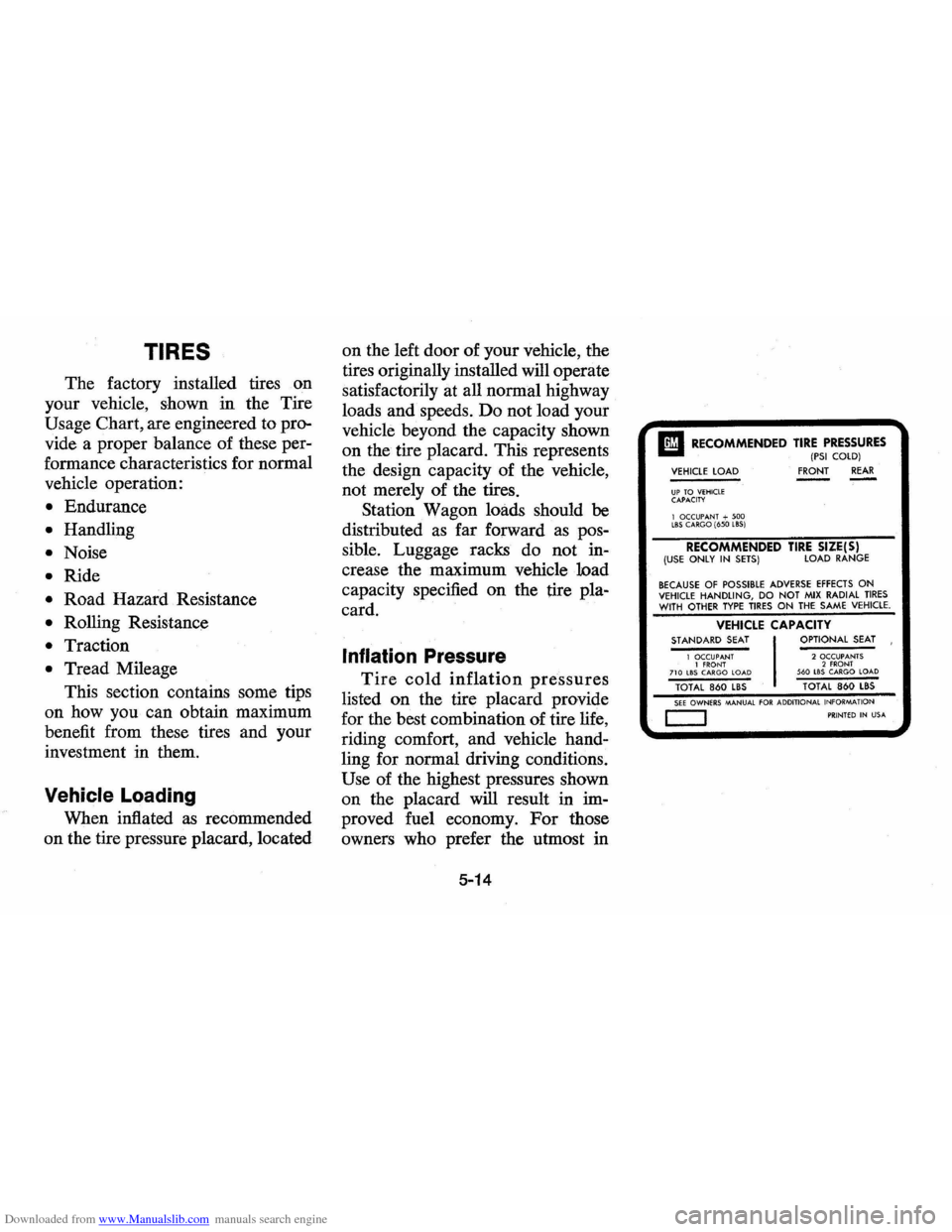
Downloaded from www.Manualslib.com manuals search engine TIRES
The factory installed tires on
your vehicle, shown in the Tire
Usage Chart, are engineered to pro
vide a proper balance of these per
formance characteristics for normal
vehicle operation:
• Endurance
• Handling
• Noise
• Ride
• Road Hazard Resistance
• Rolling Resistance
• Traction
• Tread Mileage
This section contains some tips
on how you can obtain maximum
benefit from these tires and your
investment in them.
Vehicle Loading
When inflated as recommended
on the tire pressure placard, located on
the left door of your vehicle,
the
tires originally installed will operate
satisfactorily at all normal highway
loads and speeds. Do not load your
vehicle beyond the capacity shown
on the tire placard. This represents
the design capacity of the vehicle,
not merely of the tires.
Station Wagon loads should
be
distributed as far forward as pos
sible. Luggage racks do not in
crease the maximum vehicle load
capacity specified on the tire pla
card.
Inflation Pressure
Tire cold inflation pressures
listed on the tire placard provide
for the best combination of tire life,
riding comfort, and vehicle hand
ling for normal driving conditions.
Use of the highest pressures shown
on the placard will result in
im
proved fuel economy. For those
owners who prefer the utmost in
5-14
II RECOMMENDED TIRE PRESSURES (PSI COlD) VEHICLE lOAD FRONT REAR ----UP TO VEHICLE CAPACITY
1 OCCUPANT + 500 lBS CARGO (650 lBS)
RECOMMENDED TIRE SIZE(S) (USE ONLY IN SETS) LOAD RANGE
BECAUSE OF POSSIBLE ADVERSE EFFECTS ON VEHICLE HANDLING, DO NOT MIX RADIAL TIRES WITH OTHER TYPE TIRES ON THE SAME VEHICLE.
VEHICLE CAPACITY STANDARD SEAT OPTIONAL SEAT
1 OCCUPANT 2 OCCUPANTS 1 fRONT 2 FRONT 710 lBS CARGO LOAD 560 LBS CARGO LOAD TOTAL 860 lBS TOTAL 860 lBS SEE OWNERS MANUAL FOR ADDITIONAL
INFORMATION
c::J PRINTED IN USA
Page 73 of 87
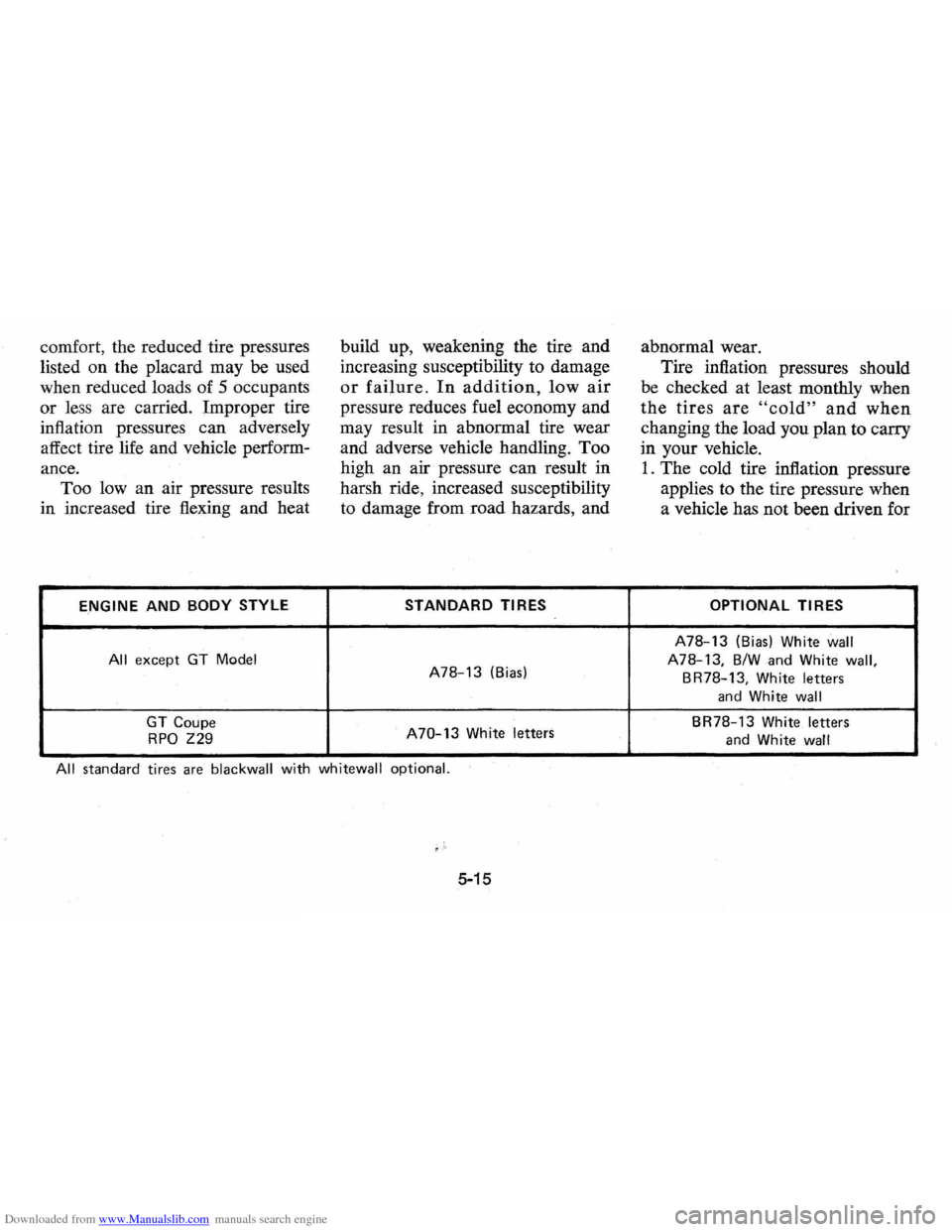
Downloaded from www.Manualslib.com manuals search engine comfort, the reduced tire pressures
listed on the placard may
be used
when reduced loads of 5 occupants
or less are carried. Improper tire
inflation pressures can adversely
affect tire life and vehicle perform
ance. Too
Iowan air pressure results
in increased tire flexing and heat
ENGINE AND BODY STYLE
All except GT Model
GT Coupe
RPO Z29
build up, weakening the tire and
increasing susceptibility to damage
or failure. In addition, low air
pressure reduces fuel economy and
may result in abnormal tire wear
and adverse vehicle handling. Too
high an air pressure can result in
harsh ride, increased susceptibility
to damage from road hazards, and
STANDARD TIRES
A78-13 (Bias)
A70-13 White letters
All standard tires are blackwall with whitewall optional.
f'"
5-15
abnormal wear.
Tire inflation pressures should
be checked at least monthly when
the tires are "cold" and when
changing the load you plan to carry
in your vehicle.
1. The cold tire inflation pressure
applies to the tire pressure when
a vehicle has not been driven for
OPTIONAL TIRES
A78-13 (Bias) White wall
A78-13, B/W and White wall,
BR78-13, White letters
and White wall
BR78-13 White letters
and White wall
Page 74 of 87
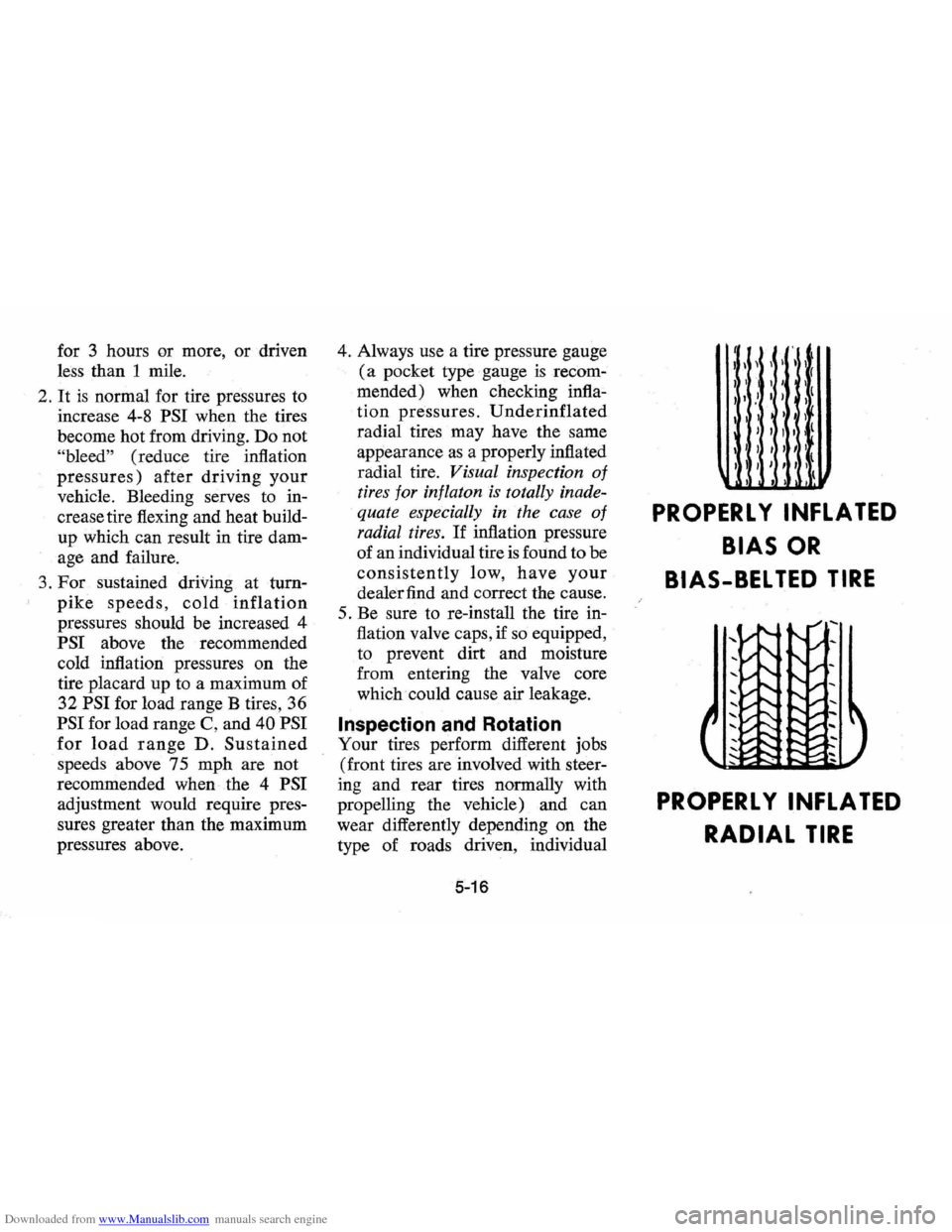
Downloaded from www.Manualslib.com manuals search engine for 3 hours or more, or driven
less than 1 mile.
2 .
It is normal for tire pressures to
increase 4-8
PSI when the tires
become hot from driving. Do not
"bleed" (reduce tire inflation
pressures) after driving your
vehicle. Bleeding serves to in
crease tire flexing and heat build
up which can result in tire dam
age and failure.
3. For sustained driving at turn
pike speeds, cold inflation
pressures should be increased 4
PSI above the recommended
cold inflation pressures on the
tire placard up to a maximum of
32
PSI for load range Btires, 36
PSI for load range C, and 40 PSI
for load range D. Sustained
speeds above 75 mph are not
recommended when the 4
PSI
adjustment would require pres
sures greater than the maximum
pressures above.
4. Always use a tire pressure gauge
(a pocket type gauge is recom
mended) when checking
infla~
tion pressures. Underinflated
radial tires may have the same
appearance
as a properly inflated
radial tire.
Visual inspection of
tires for inflaton is totally inade
quate especially in the case
of
radial tires. If inflation pressure
of an individual tire
is found to be
consistently low, have your
dealer find and correct the cause.
5. Be sure to re-install the tire in
flation valve caps, if
so equipped,
to prevent dirt and moisture
from entering the valve core
which could cause air leakage.
Inspection and Rotation
Your tires perform different jobs
(front tires are involved with steer
ing and rear tires normally with
propelling the vehicle) and can
wear differently depending on the
type of roads driven, individual
5-16
1\ II(
" I I ,t " I' ,I
I' I I j , I I I
I I , I I I I
I I I I I I
I 1
PROPERL Y INFLATED
BIAS OR
BIAS-BEL TED TIRE
PROPERL Y INFLATED
RADIAL TIRE
Page 80 of 87
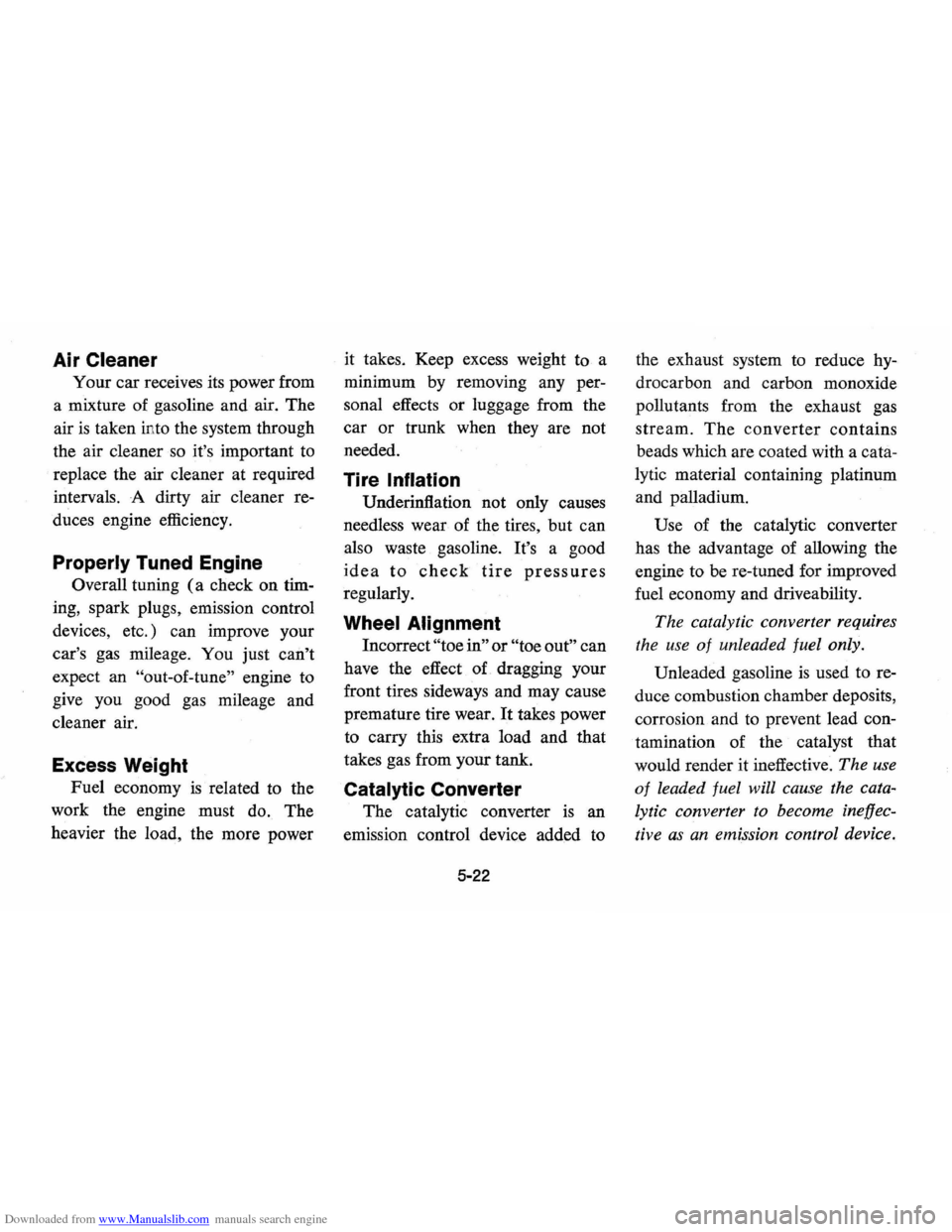
Downloaded from www.Manualslib.com manuals search engine Air Cleaner
Your car receives its power from
a mixture of gasoline and air. The
air
is taken in to the system through
the air cleaner
so it's important to
replace the air cleaner at required
intervals. A dirty air cleaner re
duces engine efficiency.
Properly Tuned Engine
Overall tuning (a check on tim
ing, spark plugs, emission control
devices, etc.) can improve your
car's gas mileage. You just can't
expect an
"out-of-tune" engine to
give you good gas mileage and
cleaner air.
Excess Weight
Fuel economy is related to the
work the engine must do. The
heavier the load, the more power it
takes. Keep excess weight to a
minimum by removing any per
sonal effects or luggage from the
car or trunk when they are not
needed.
Tire Inflation
Underinfiation not only causes
needless wear of the tires, but can
also waste gasoline. It's a good
idea to check tire pressures
regularly.
Wheel Alignment
Incorrect "toe in" or "toe out" can
have the effect
of dragging your
front tires sideways and may cause
premature tire wear.
It takes power
to carry this extra load and that
takes gas from your tank.
Catalytic Converter
The catalytic converter IS an
emission control device added to
5-22
the exhaust system to reduce hy
drocarbon and carbon monoxide
pollutants from the exhaust gas
stream.
The converter contains
beads which are coated with a cata
lytic material containing platinum
and palladium.
Use of the catalytic converter
has the advantage of allowing the
engine to be re-tuned for improved
fuel economy and driveability.
The catalytic converter requires
the use
of unleaded fuel only.
Unleaded gasoline is used to re
duce combustion chamber deposits,
corrosion and
to prevent lead con
tamination of the catalyst that
would render it ineffective.
The use
of leaded fuel will cause the cata
lytic converter to
become ineffec
tive as an emission control device.